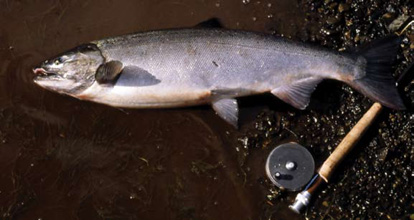Practice Methods

Perhaps the most effective practice method is to start with the amount of line that you can cast efficiently. Practice casting perfect loops on both the back and forward casts. In addition learn to adjust the loop size on command. Once you are proficient casting at a short line length, gradually increase the distance in about 5 foot increments. The technical demands grow as you increase the casting distance. With time you will be casting a long line with ease.
Hula hoop practice is good for both accuracy and loop control. Prop one up vertically and practice casting a narrow loop through the hoop. To develop accuracy, lay the hoops down at different distances and practice placing the fly inside the hoops.
Target practice also helps develop accuracy. Try casting to the edge of the flower garden, or underneath a tree. Place tennis balls out on the lawn at various distances and cast to them. Again the hula hoops make good targets, but my mind is programmed to cast to the edge of them and not to their midst. I enjoy casting to our pet cat; cats get excited and love to play with the yarn fly. In practice, cast to the cat just as if it was a fish. Lay the yarn down gently in front of the cat and watch its excitement in pouncing on the yarn. The cat provides a moveable target with lots of odd angles. Plus it relishes the activity. Cast gently so the cat will not be harmed. Use a tuft of soft yarn tied onto the leader. Pretend the cat is a willing fish ready to take a properly presented fly.
Another practice goal is to perfect your casting using as little energy expenditure as possible. Rely upon exact timing, coordinating accelerations, short casting strokes and sudden stops to make the rod do most of the work. With time the rod will be like an extension of your arm and it will amaze you how effortlessly you can cast.
During practice sessions place emphasis on the power stroke and stop. These are the critical movements needed for good casting technique.
For improving distance, practice shooting as much line as possible. Shoot line on the backcast. The backcast is the weakest casting stroke. By learning to shoot line on the backcast you must perfect its line speed and tight narrow loop control; likewise, cast shooting line on the forward cast.
Small targets, such as a cup or a loaded mousetrap, are good practice. You must precisely cast to set off the trap or to place the fly inside the cup.
Fly casting is similar to basketball. With repetitive practice, distance and accuracy skills are learned. Daily practice sessions lead to success; without practice, casting perfection is not possible.
My most enjoyable practice sessions occur on the stream when casting to real fish. Try to perfect your casting skills on a week’s fishing trip.


© 2025 The Gale Group, Inc. All rights reserved.
© 2025 Perigee Learning LLC. All rights reserved.
LoveTheOutdoors.com is owned and operated by Advameg, Inc. © 2025 Advameg, Inc.
Camping Adventures • Dutch Oven Cooking • Sports Knots
Fly Tying • Freshwater Fishing • Fly Fishing

